2017 NISSAN ARMADA battery
[x] Cancel search: batteryPage 17 of 614
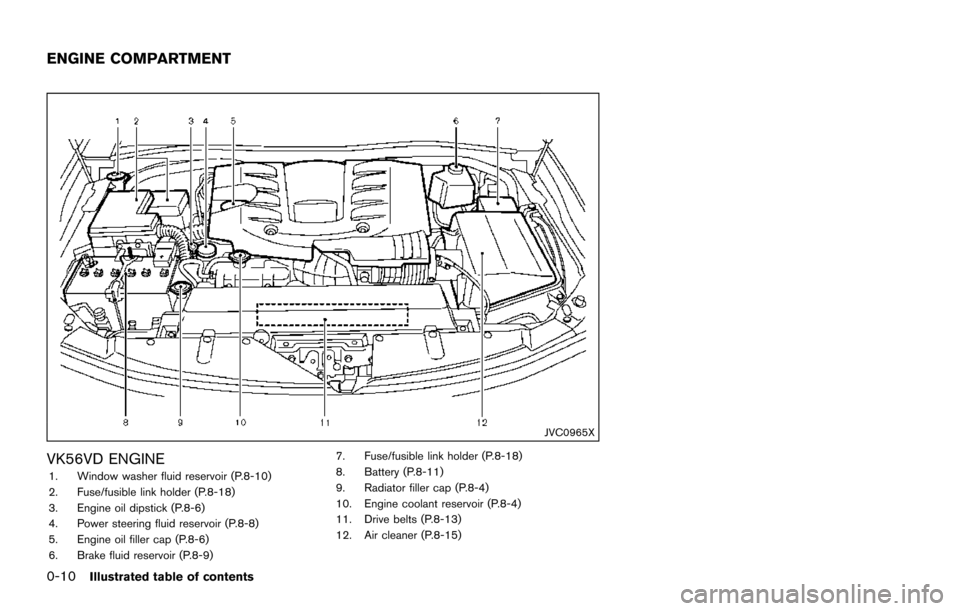
0-10Illustrated table of contents
JVC0965X
VK56VD ENGINE1. Window washer fluid reservoir (P.8-10)
2. Fuse/fusible link holder (P.8-18)
3. Engine oil dipstick (P.8-6)
4. Power steering fluid reservoir (P.8-8)
5. Engine oil filler cap (P.8-6)
6. Brake fluid reservoir (P.8-9)7. Fuse/fusible link holder (P.8-18)
8. Battery (P.8-11)
9. Radiator filler cap (P.8-4)
10. Engine coolant reservoir (P.8-4)
11. Drive belts (P.8-13)
12. Air cleaner (P.8-15)
ENGINE COMPARTMENT
Page 22 of 614
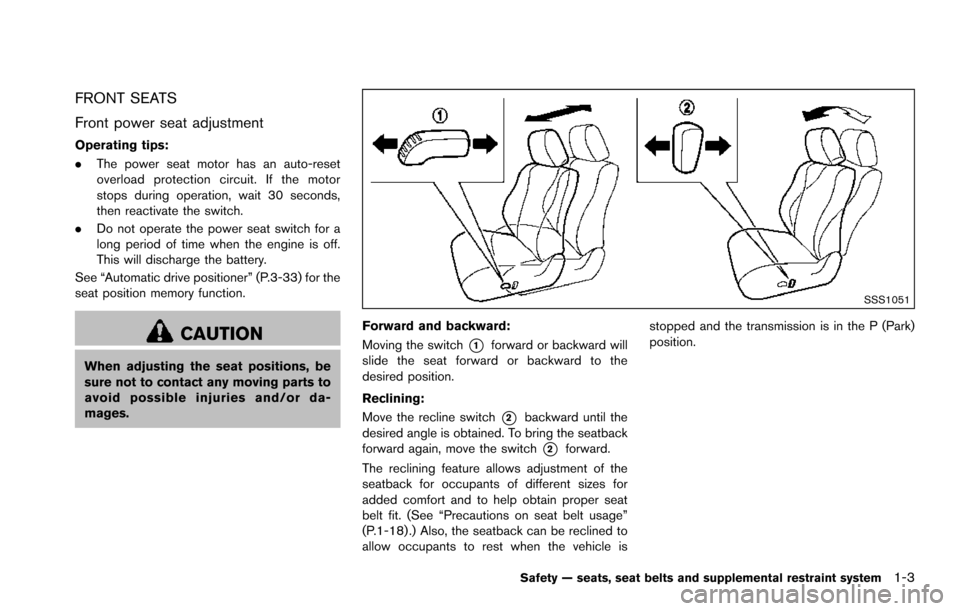
FRONT SEATS
Front power seat adjustment
Operating tips:
.The power seat motor has an auto-reset
overload protection circuit. If the motor
stops during operation, wait 30 seconds,
then reactivate the switch.
. Do not operate the power seat switch for a
long period of time when the engine is off.
This will discharge the battery.
See “Automatic drive positioner” (P.3-33) for the
seat position memory function.
CAUTION
When adjusting the seat positions, be
sure not to contact any moving parts to
avoid possible injuries and/or da-
mages.
SSS1051
Forward and backward:
Moving the switch
*1forward or backward will
slide the seat forward or backward to the
desired position.
Reclining:
Move the recline switch
*2backward until the
desired angle is obtained. To bring the seatback
forward again, move the switch
*2forward.
The reclining feature allows adjustment of the
seatback for occupants of different sizes for
added comfort and to help obtain proper seat
belt fit. (See “Precautions on seat belt usage”
(P.1-18) .) Also, the seatback can be reclined to
allow occupants to rest when the vehicle is stopped and the transmission is in the P (Park)
position.
Safety — seats, seat belts and supplemental restraint system1-3
Page 28 of 614
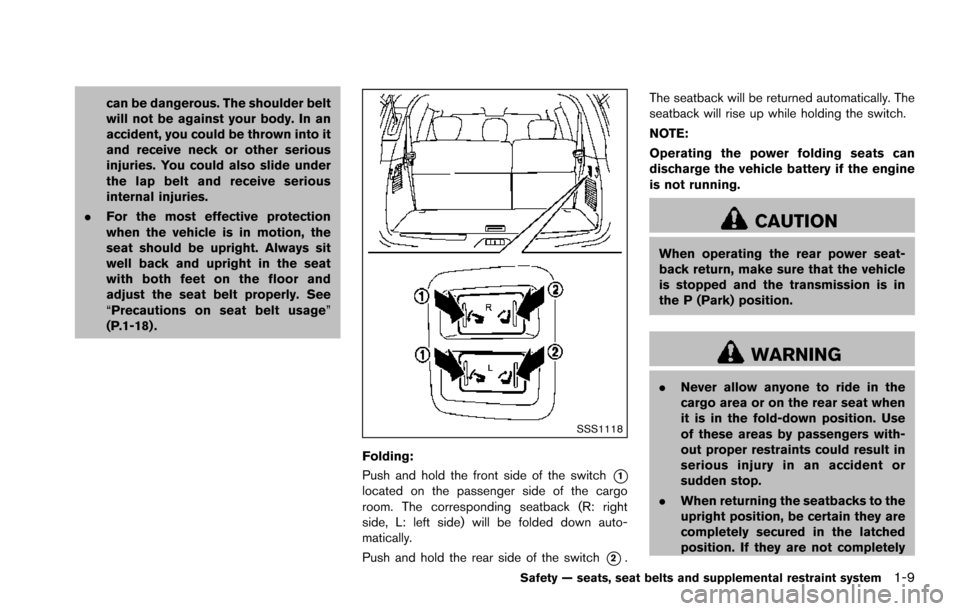
can be dangerous. The shoulder belt
will not be against your body. In an
accident, you could be thrown into it
and receive neck or other serious
injuries. You could also slide under
the lap belt and receive serious
internal injuries.
. For the most effective protection
when the vehicle is in motion, the
seat should be upright. Always sit
well back and upright in the seat
with both feet on the floor and
adjust the seat belt properly. See
“Precautions on seat belt usage”
(P.1-18) .
SSS1118
Folding:
Push and hold the front side of the switch
*1located on the passenger side of the cargo
room. The corresponding seatback (R: right
side, L: left side) will be folded down auto-
matically.
Push and hold the rear side of the switch
*2. The seatback will be returned automatically. The
seatback will rise up while holding the switch.
NOTE:
Operating the power folding seats can
discharge the vehicle battery if the engine
is not running.
CAUTION
When operating the rear power seat-
back return, make sure that the vehicle
is stopped and the transmission is in
the P (Park) position.
WARNING
.
Never allow anyone to ride in the
cargo area or on the rear seat when
it is in the fold-down position. Use
of these areas by passengers with-
out proper restraints could result in
serious injury in an accident or
sudden stop.
. When returning the seatbacks to the
upright position, be certain they are
completely secured in the latched
position. If they are not completely
Safety — seats, seat belts and supplemental restraint system1-9
Page 91 of 614
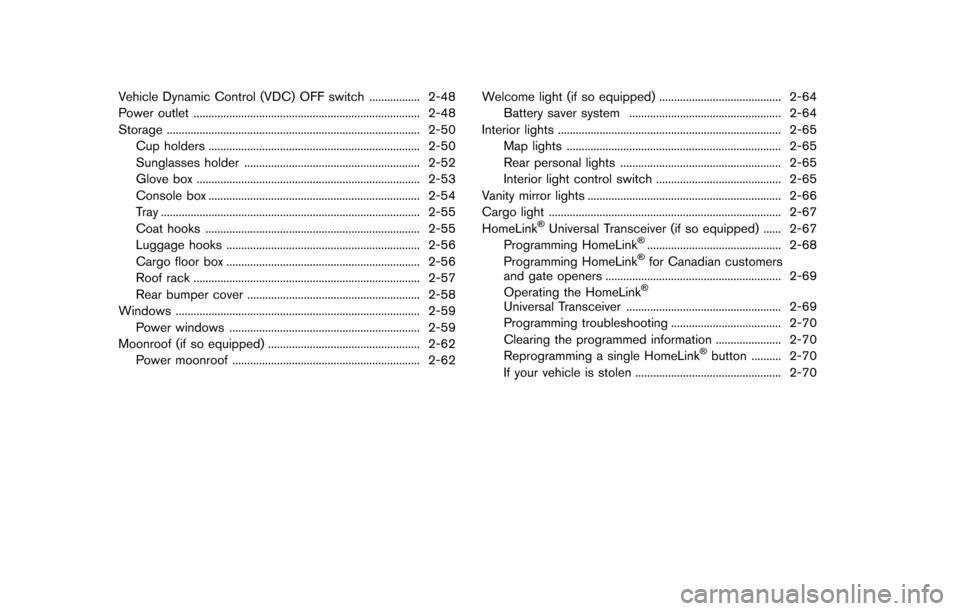
Vehicle Dynamic Control (VDC) OFF switch ................. 2-48
Power outlet ........................................................................\
.... 2-48
Storage ........................................................................\
............. 2-50Cup holders ....................................................................... 2-50
Sunglasses holder ........................................................... 2-52
Glove box ........................................................................\
... 2-53
Console box ....................................................................... 2-54
Tray ........................................................................\
............... 2-55
Coat hooks ........................................................................\
2-55
Luggage hooks ................................................................. 2-56
Cargo floor box ................................................................. 2-56
Roof rack ........................................................................\
.... 2-57
Rear bumper cover .......................................................... 2-58
Windows ........................................................................\
.......... 2-59
Power windows ................................................................ 2-59
Moonroof (if so equipped) ................................................... 2-62 Power moonroof ............................................................... 2-62 Welcome light (if so equipped) ......................................... 2-64
Battery saver system ................................................... 2-64
Interior lights ........................................................................\
... 2-65 Map lights ........................................................................\
2-65
Rear personal lights ...................................................... 2-65
Interior light control switch .......................................... 2-65
Vanity mirror lights ................................................................. 2-66
Cargo light ........................................................................\
...... 2-67
HomeLink
�ŠUniversal Transceiver (if so equipped) ...... 2-67
Programming HomeLink�Š............................................. 2-68
Programming HomeLink�Šfor Canadian customers
and gate openers ........................................................... 2-69
Operating the HomeLink
�Š
Universal Transceiver .................................................... 2-69
Programming troubleshooting ..................................... 2-70
Clearing the programmed information ...................... 2-70
Reprogramming a single HomeLink
�Šbutton .......... 2-70
If your vehicle is stolen ................................................. 2-70
Page 98 of 614
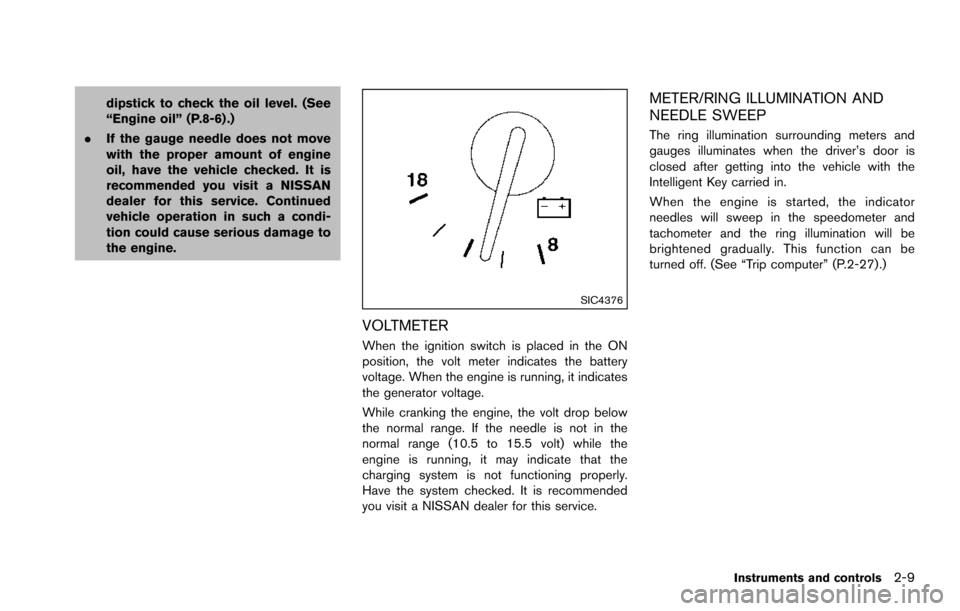
dipstick to check the oil level. (See
“Engine oil” (P.8-6) .)
. If the gauge needle does not move
with the proper amount of engine
oil, have the vehicle checked. It is
recommended you visit a NISSAN
dealer for this service. Continued
vehicle operation in such a condi-
tion could cause serious damage to
the engine.
SIC4376
VOLTMETER
When the ignition switch is placed in the ON
position, the volt meter indicates the battery
voltage. When the engine is running, it indicates
the generator voltage.
While cranking the engine, the volt drop below
the normal range. If the needle is not in the
normal range (10.5 to 15.5 volt) while the
engine is running, it may indicate that the
charging system is not functioning properly.
Have the system checked. It is recommended
you visit a NISSAN dealer for this service.
METER/RING ILLUMINATION AND
NEEDLE SWEEP
The ring illumination surrounding meters and
gauges illuminates when the driver’s door is
closed after getting into the vehicle with the
Intelligent Key carried in.
When the engine is started, the indicator
needles will sweep in the speedometer and
tachometer and the ring illumination will be
brightened gradually. This function can be
turned off. (See “Trip computer” (P.2-27) .)
Instruments and controls2-9
Page 112 of 614
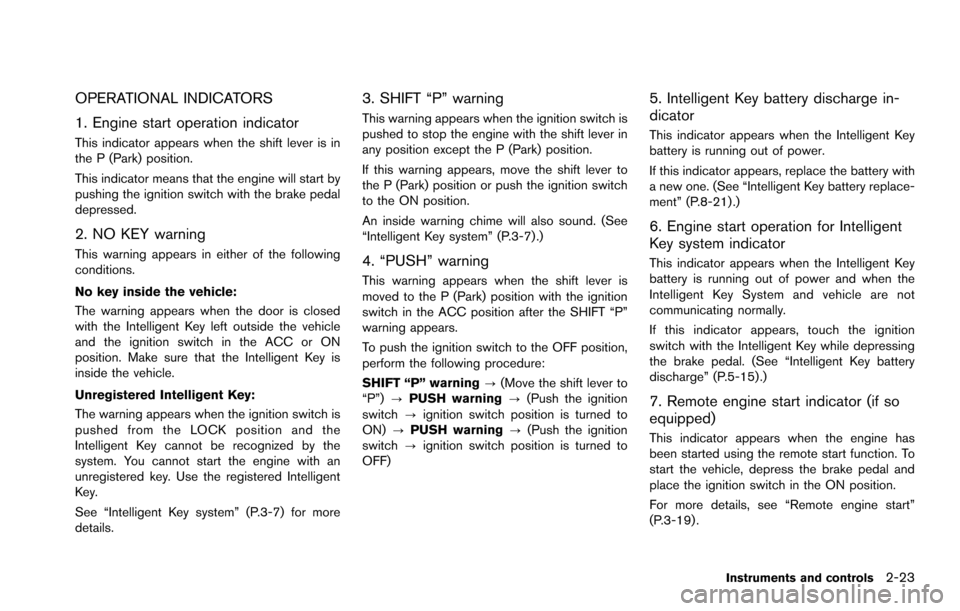
OPERATIONAL INDICATORS
1. Engine start operation indicator
This indicator appears when the shift lever is in
the P (Park) position.
This indicator means that the engine will start by
pushing the ignition switch with the brake pedal
depressed.
2. NO KEY warning
This warning appears in either of the following
conditions.
No key inside the vehicle:
The warning appears when the door is closed
with the Intelligent Key left outside the vehicle
and the ignition switch in the ACC or ON
position. Make sure that the Intelligent Key is
inside the vehicle.
Unregistered Intelligent Key:
The warning appears when the ignition switch is
pushed from the LOCK position and the
Intelligent Key cannot be recognized by the
system. You cannot start the engine with an
unregistered key. Use the registered Intelligent
Key.
See “Intelligent Key system” (P.3-7) for more
details.
3. SHIFT “P” warning
This warning appears when the ignition switch is
pushed to stop the engine with the shift lever in
any position except the P (Park) position.
If this warning appears, move the shift lever to
the P (Park) position or push the ignition switch
to the ON position.
An inside warning chime will also sound. (See
“Intelligent Key system” (P.3-7) .)
4. “PUSH” warning
This warning appears when the shift lever is
moved to the P (Park) position with the ignition
switch in the ACC position after the SHIFT “P”
warning appears.
To push the ignition switch to the OFF position,
perform the following procedure:
SHIFT “P” warning?(Move the shift lever to
“P”) ?PUSH warning ?(Push the ignition
switch ?ignition switch position is turned to
ON) ?PUSH warning ?(Push the ignition
switch ?ignition switch position is turned to
OFF)
5. Intelligent Key battery discharge in-
dicator
This indicator appears when the Intelligent Key
battery is running out of power.
If this indicator appears, replace the battery with
a new one. (See “Intelligent Key battery replace-
ment” (P.8-21) .)
6. Engine start operation for Intelligent
Key system indicator
This indicator appears when the Intelligent Key
battery is running out of power and when the
Intelligent Key System and vehicle are not
communicating normally.
If this indicator appears, touch the ignition
switch with the Intelligent Key while depressing
the brake pedal. (See “Intelligent Key battery
discharge” (P.5-15).)
7. Remote engine start indicator (if so
equipped)
This indicator appears when the engine has
been started using the remote start function. To
start the vehicle, depress the brake pedal and
place the ignition switch in the ON position.
For more details, see “Remote engine start”
(P.3-19) .
Instruments and controls2-23
Page 125 of 614
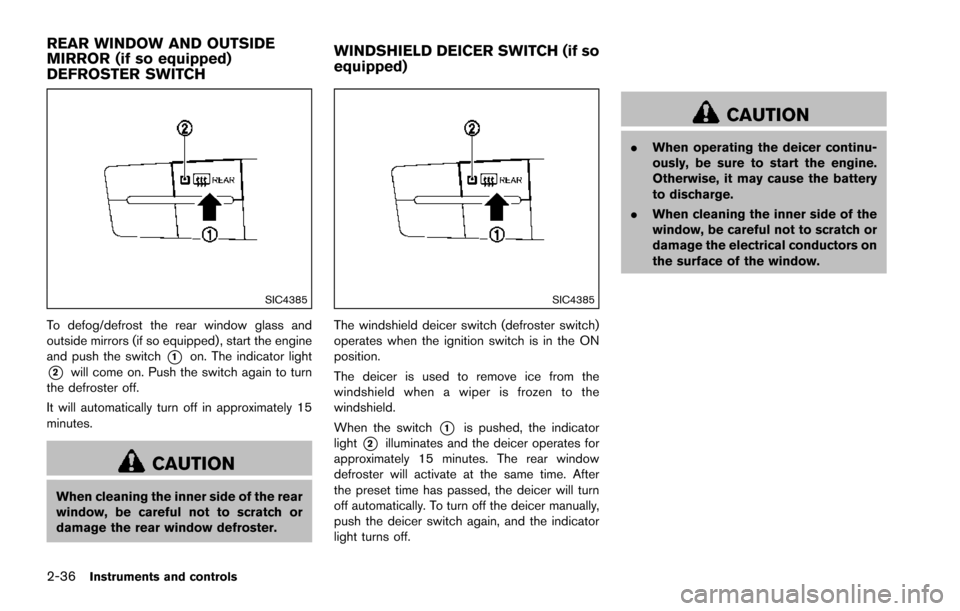
2-36Instruments and controls
SIC4385
To defog/defrost the rear window glass and
outside mirrors (if so equipped) , start the engine
and push the switch
*1on. The indicator light
*2will come on. Push the switch again to turn
the defroster off.
It will automatically turn off in approximately 15
minutes.
CAUTION
When cleaning the inner side of the rear
window, be careful not to scratch or
damage the rear window defroster.
SIC4385
The windshield deicer switch (defroster switch)
operates when the ignition switch is in the ON
position.
The deicer is used to remove ice from the
windshield when a wiper is frozen to the
windshield.
When the switch
*1is pushed, the indicator
light
*2illuminates and the deicer operates for
approximately 15 minutes. The rear window
defroster will activate at the same time. After
the preset time has passed, the deicer will turn
off automatically. To turn off the deicer manually,
push the deicer switch again, and the indicator
light turns off.
CAUTION
. When operating the deicer continu-
ously, be sure to start the engine.
Otherwise, it may cause the battery
to discharge.
. When cleaning the inner side of the
window, be careful not to scratch or
damage the electrical conductors on
the surface of the window.
REAR WINDOW AND OUTSIDE
MIRROR (if so equipped)
DEFROSTER SWITCH WINDSHIELD DEICER SWITCH (if so
equipped)
Page 128 of 614
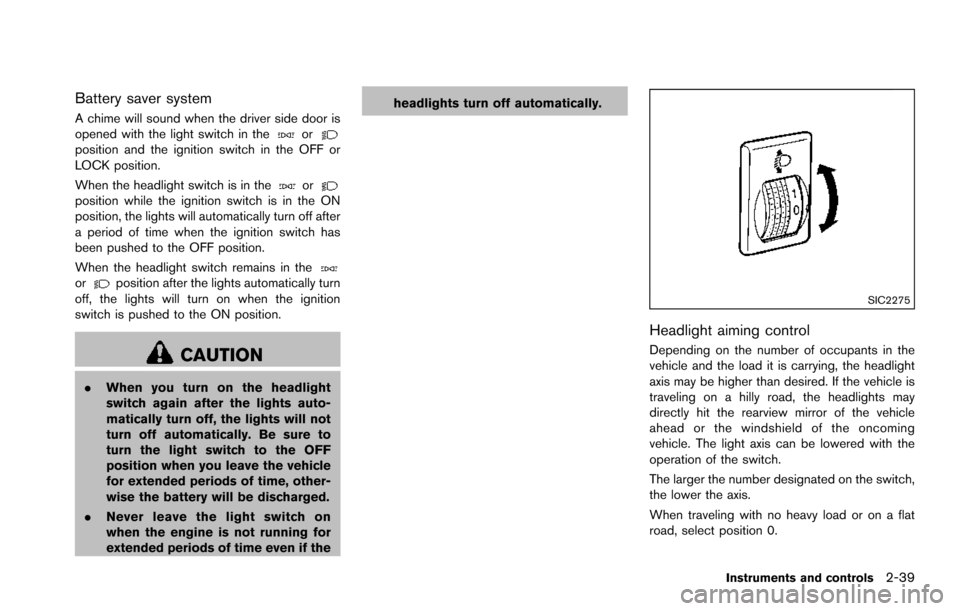
Battery saver system
A chime will sound when the driver side door is
opened with the light switch in theorposition and the ignition switch in the OFF or
LOCK position.
When the headlight switch is in the
orposition while the ignition switch is in the ON
position, the lights will automatically turn off after
a period of time when the ignition switch has
been pushed to the OFF position.
When the headlight switch remains in the
orposition after the lights automatically turn
off, the lights will turn on when the ignition
switch is pushed to the ON position.
CAUTION
. When you turn on the headlight
switch again after the lights auto-
matically turn off, the lights will not
turn off automatically. Be sure to
turn the light switch to the OFF
position when you leave the vehicle
for extended periods of time, other-
wise the battery will be discharged.
. Never leave the light switch on
when the engine is not running for
extended periods of time even if the headlights turn off automatically.
SIC2275
Headlight aiming control
Depending on the number of occupants in the
vehicle and the load it is carrying, the headlight
axis may be higher than desired. If the vehicle is
traveling on a hilly road, the headlights may
directly hit the rearview mirror of the vehicle
ahead or the windshield of the oncoming
vehicle. The light axis can be lowered with the
operation of the switch.
The larger the number designated on the switch,
the lower the axis.
When traveling with no heavy load or on a flat
road, select position 0.
Instruments and controls2-39